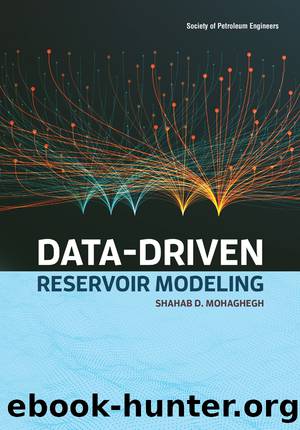Data-Driven Reservoir Modeling by Shahab D. Mohaghegh;

Author:Shahab D. Mohaghegh;
Language: eng
Format: epub
Publisher: SPE
8.2 Dynamic Data
Well logs, core analysis, and 3D seismic (any parameter or variable that does not change as a function of time) are among the static data that are used in the top-down model through the spatio-temporal database. Other parameters such as wellhead pressure, number of days of production in a given month (if the time resolution happens to be monthly), choke size, change in completion length (because of new perforations or squeezing off old perforations, use of ICVs, or other factors) are among the dynamic parameters.
Many of the dynamic parameters represent human intervention in production. Some of these interventions are intentional (such as changing the choke size or increasing the completion footage, or stimulating a well), and some are unintentional (such as changes in wellhead pressure because of surface facility limitations or changes to the surface facility in unrelated areas that impact the backpressure on the well). It is of utmost importance to teach the top-down model about the differences between reservoir behavior and human intervention.
The differences between the impacts of the reservoir characteristics and those of human intervention (operational issues) that are inherent in the production data need to be communicated to the top-down model. The only means to communicate such information with the top-down model is through data. Obviously, some of the observed production behavior results from reservoir characteristics (e.g., the amount of the fluid being produced and the extent of decline in the production), while other observed behavior results from the impact of operational issues (e.g., sudden changes in production behavior such as very sharp decline to zero production or a sharp increase in production).
The top-down model will be able to distinguish between the two sets of characteristics and deconvolve the related signals only after it has learned, through historical data, that there is a difference between signals coming from the reservoir and those that have been impacted by the operational constraints. The training of the top-down model is conducted through the collected records and parameters in the spatio-temporal database that carries such information (in a convoluted fashion). The spatio-temporal database is the only source of information that is used to educate the top-down model, whereupon it is expected to properly respond to the questions that are posed to it once it is trained.
It should be noted that the presentation of differences between the impacts related to reservoir characteristics and those related to operational constraints is performed implicitly, not explicitly. An explicit representation is usually in the form of a mathematical equation, while an implicit representation is through multiple, and sometimes redundant, data records. An explicit representation is easy to understand, detect, and digest, while deconvolution of an implicit representation is not very straightforward. Because the top-down model is a data-driven model and not a physics-based model, explicit mathematical equations for deconvolution are not used during their development. Furthermore, presentation of an explicit mathematical equation is an interpretation of our current understanding of the physics that we are intentionally staying away from while developing a top-down model.
Download
This site does not store any files on its server. We only index and link to content provided by other sites. Please contact the content providers to delete copyright contents if any and email us, we'll remove relevant links or contents immediately.
| Coatings, Ceramics & Glass | Cosmetics |
| Fluid Dynamics | Plant Design |
| Plastics | Unit Operations & Transport Phenomena |
Whiskies Galore by Ian Buxton(40557)
Introduction to Aircraft Design (Cambridge Aerospace Series) by John P. Fielding(32357)
Small Unmanned Fixed-wing Aircraft Design by Andrew J. Keane Andras Sobester James P. Scanlan & András Sóbester & James P. Scanlan(32154)
Craft Beer for the Homebrewer by Michael Agnew(17466)
Turbulence by E. J. Noyes(7065)
The Complete Stick Figure Physics Tutorials by Allen Sarah(6653)
Kaplan MCAT General Chemistry Review by Kaplan(6077)
The Thirst by Nesbo Jo(5809)
Bad Blood by John Carreyrou(5793)
Learning SQL by Alan Beaulieu(5438)
Weapons of Math Destruction by Cathy O'Neil(5062)
Man-made Catastrophes and Risk Information Concealment by Dmitry Chernov & Didier Sornette(4759)
iGen by Jean M. Twenge(4710)
Digital Minimalism by Cal Newport;(4593)
Life 3.0: Being Human in the Age of Artificial Intelligence by Tegmark Max(4529)
Audition by Ryu Murakami(4117)
Electronic Devices & Circuits by Jacob Millman & Christos C. Halkias(4057)
1,001 ASVAB Practice Questions For Dummies by Powers Rod(4051)
Pale Blue Dot by Carl Sagan(4025)
